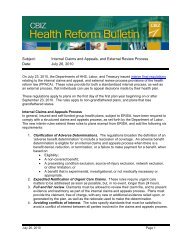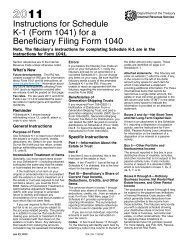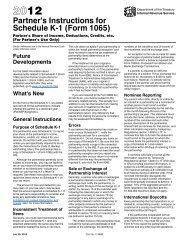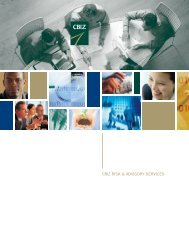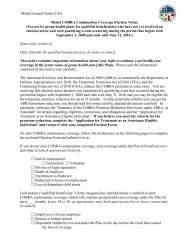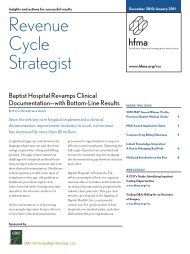Revenue Cycle Strategist - CBIZ
Revenue Cycle Strategist - CBIZ
Revenue Cycle Strategist - CBIZ
Create successful ePaper yourself
Turn your PDF publications into a flip-book with our unique Google optimized e-Paper software.
Insights and actions for successful resultsSeptember 2010<strong>Revenue</strong><strong>Cycle</strong><strong>Strategist</strong>www.hfma.org/rcsThe Business of HospitalCharge CaptureBy Jennifer Wexler and Kelly BucciWhether the hospital charge capture function is centralized ordecentralized, technology will increase the effectiveness of theprocess.INSIDE THIS ISSUEResponding to RAC Requests: ArePostdischarge Queries Appropriate? 42010 MAP Award Winner Profile:Baylor Medical Center Irving 5Like most businesses, hospitals must beable to catalog, appropriately charge, andreconcile all services provided to theircustomers. In the case of hospitals, however,patients are the customers, andeach patient who passes through thedoors of a hospital will experience a differentencounter. Every day, hospitalsattempt the monumental task of makingsure that each patient is charged comprehensivelyand compliantly for allservices rendered and supplies andpharmaceuticals used.Relative to these complexities, the hospitalcharge capture process is often difficultand subject to a variety ofbreakdowns. After patient services havebeen rendered, clinical staff membersusually are responsible for preciselydocumenting the five Ws—the who, what,when, where, and why of that patientencounter—and then accurately translatingthe complete patient encounter tocharges.Although it is often clinically clear whatpatient services have been rendered,specific payer billing requirements andgovernment regulation frequently drivehow services should be documented inthe patient record and subsequentlyreported on the patient bill for a hospitalto be paid. The clinical ability to satisfypayer documentation, coding, andcharging requirements necessary toSafety-Net Technology HelpsINTEGRIS Health Reduce Denials 6Coding Q&A 7Patient Margin for U.S.Not-for-Profit and Public Hospitals 8WEB EXTRA!Guidance for Responding to Investigationsat www.hfma.org/rcsNEW HFMA RESOURCEIssue Analysis: Accounting for RAC AuditAdjustments and Exposures, www.hfma.org/Templates/InteriorMaster.aspx?id=21387Sponsored by
eceive appropriate payment is difficultto administer.What are hospitals doing to address thisissue? Observation of national leadingpractice guidelines in the revenue cyclespecifically related to maintenance of thehospital chargemaster and charge captureprocesses demonstrates that manyhospitals have successfully implementedteams of individuals to support operationalcharge capture issues. For purposesof this discussion, the management of themiddle revenue cycle (the capture ofpatient charges after services have beenrendered)—maintenance of the hospitalchargemaster and charge capture processas well as related activities—is segregatedinto two approaches: the centralizedapproach and the decentralizedapproach.Centralized Charge Capture ApproachThe centralized middle revenue cyclemodel typically consists of a chargeRobert FrombergCarole BolsterEditor-in-ChiefSenior EditorAmy D. LarsenProduction<strong>Revenue</strong> <strong>Cycle</strong> <strong>Strategist</strong> is published 10 times a year bythe Healthcare Financial Management Association, TwoWestbrook Corporate Center, Suite 700, Westchester, IL60154Presorted nonprofit postage paid in Chicago, IL 60607.©2010 Healthcare Financial Management Association.Volume 7, Number 7Subscriptions are $110 for HFMA members and $165for other individuals and organizations. Subscribe online atwww.hfma.org/rcs or call 1-800-252-HFMA, ext 2.To order reprints, call 1-800-252-HFMA, ext. 387.To submit an article, contact Carole Bolster atcbolster@hfma.org.<strong>Revenue</strong> <strong>Cycle</strong> <strong>Strategist</strong> is indexed with Hospital andHealth Administration Index and the HealthSTAR database.Material published in <strong>Revenue</strong> <strong>Cycle</strong> <strong>Strategist</strong> is providedsolely for the information and education of its readers.HFMA does not endorse the published material or warrantor guarantee its accuracy. The statements and opinions in<strong>Revenue</strong> <strong>Cycle</strong> <strong>Strategist</strong> articles and columns are thoseof the authors and not those of HFMA. References tocommercial manufacturers, vendors, products, or servicesthat may appear in such articles or columns do not constituteendorsements by HFMA.ISSN 1549-0858WEB EXTRA!See illustrations of centralized anddecentralized approaches to chargecapture at www.hfma.org/rcs.capture team that supports several facetsof the middle revenue cycle. The modelleverages a revenue management departmentor team of individuals whoseresponsibilities include, but may not belimited to:> Management of the hospitalchargemaster> Oversight of the clinical charge captureprocess to include clinical training> Retrospective audit and clinical and/orcoding process improvement> Participation in or leadership of revenueintegrity steering committees> Evaluation of new service lines relatedto reimbursement valuation> Monitoring of daily departmentrevenues and late charges> Patient-initiated price estimatesLeading practice suggests that managementof this centralized model characteristicallyresides within the financedepartment (or related area, such as thebusiness office or corporate compliance)of the organization and reporting to senioradministration, such as a CFO. Withdirection or management outside of theclinical operations facet, this model allowsfor autonomy of those individuals managingthe charge capture process without theexpectation of clinical participation. Anexample of this type of resource might bethat of the charge analyst.The charge analyst has charge captureresponsibility to the clinical departmentbut reports upward through the financedepartment. The activities of this positioncould include the following.Charge posting and reconciliation. Thecharge analyst may be tasked with theresponsibility of charging for all servicesrendered within a clinical department ormay only perform daily charge reconciliationprocedures for that department.Documentation validation and clinical staffeducation. As the charge analyst reviewsdocumentation relative to chargesposted, real-time feedback to clinicalstaff and verification or correction ofdocumentation can be explored.Management of daily revenue. By leveraginghistorical information, the chargeanalyst can assist in finding missing orinappropriate charging by analyzing dailyrevenue trending data. This allows theclinical area to find charge errors relatedto key stroke errors, system interfacediscrepancies, or any variety of contributingfactors.Oversight of the charge analyst, especiallyin a multihospital organization,could also involve a clinical liaison. Theresponsibilities of the clinical liaisonwould be to provide oversight and clinicalknowledge transfer to charge analystsallocated to specific clinical departments.The clinical liaison might alsoreport directly to the director of revenuemanagement, who then in turn mightreport upward to the CFO.View an illustration of the centralizedorganizational approach to charge captureat www.hfma.org/rcs.Pros and cons of the centralized chargecapture model may include the following:> A clear delineation of roles is needed.Responsibilities, both clinical andfinancial, are well understood as isreporting structure.> The model supports real-time chargecapture feedback. Charge analysts canprovide documentation feedback toclinical staff, allowing for the capture ofcharges that would be otherwisemissed.2 September 2010 <strong>Revenue</strong> <strong>Cycle</strong> <strong>Strategist</strong>
This model may be costly. Although thebenefit may outweigh the cost, manyhospitals find it costly to implementthis approach.Decentralized Charge Capture ApproachThe decentralized model depends heavilyon clinical department operations toaccomplish efficient patient charge capture.The clinical staff, more than likely,are responsible for most aspects of thecharge capture process, including bothcharging and reconciling those dailycharges. This approach places the bulk ofdaily revenue generation for any givendepartment on patient care staff, whomay not always understand governmentalor fiscal intermediary rules, regulations,or documentation guidelinesregarding charging for services.A decentralized model usually has thefollowing characteristics:> Clinical staff are responsible for dailyrevenue capture and charge reconciliationprocedures.> Clinical staff are responsible forchargemaster maintenance on codesthat apply to their department.> The chargemaster department may ormay not have specific people dedicatedto specific clinical departments.> Any coordination for manual chargesheets or automated charge screenchanges is usually the responsibility ofthe clinical department.> The use of technology to support theclinicians in daily charge capture issometimes not seen.Pros and cons of the decentralizedcharge capture model may include thefollowing:> Clinical staff need to focus on providingpatient care and understand billing,compliance, and coding regulations.Clinical personnel may not understandthe regulation and revenue aspect ofclinical care.> Daily charge reconciliation is oftendelayed or not performed at all. Clinicalareas do not perform charge reconciliation,a very important exercise and crucialto compliant charge capture.> This model is relatively inexpensive.Charge capture is reliant on staff currentlyin place.> There is insufficient support structureto realize all appropriate revenueswithin each clinical area. Clinical areasmay find it difficult to glean the supportneeded to efficiently administer theirchargemaster and manage the chargecapture process.View an illustration of the decentralizedorganizational approach to chargecapture at www.hfma.org/rcs.Using Technology to Improve ChargeCaptureAlthough both models have benefits anddrawbacks, improving the charge captureprocess is possible. Regardless of themodel used, many organizations havefound that using charge capture technologyresolves many problems.In the case of the centralized model, acharge capture tool might leverage therevenue management support staff tomore efficiently and holistically managethe charge capture process. Results canbe trended and used to prepare clinicaleducation if applicable. In the decentralizedmodel, efficient charge capturedepends solely on clinical participation.In this case, charge capture softwareshould provide a medium by which clinicalstaff can understand governmentaland charge capture billing guidelinesrelative to the day-to-day charging andcharge reconciliation process.In either model, by prospectivelyaddressing all billing issues, whether ornot related to missing or inaccuratecharging, hospitals can captureadditional revenue, increase operationalefficiency, remain compliant, and significantlyimprove claim turnaround.This achievement results in immediateimprovement to profit margins.Effective charge capture software shouldhave the following key features:> Prospective identification of missingcharges on bills with a workflowprocess for clinical or support staff tocorrect these opportunities before thebill is scrubbed or dropped to the payer> Identification of Medicare-specificNational Correct Coding Initiative(NCCI) issues between services representedon the bill prospectively withclinical explanation to support cliniciantransparency in understanding theseedits> Recognition of pricing opportunities atthe bill item level to enable clinical orsupport staff to identify those clinicalservices, whether time-based or hardcodedin the chargemaster, that arepriced less than Medicare ambulatorypayment classification> Capabilities to identify both adult andpediatric minimum and maximumpharmaceutical dosage variance> Identification of Medicare medicallyunlikely edits to be reviewed by clinicalstaff with a mechanism by which to correctthese edits> A method by which daily departmentcharges and late charges can be monitored(By benchmarking and trendingboth daily charges and late charges bydepartment, hospitals can be alerted tovariances.)In addition to these, a charge captureproduct should also provide the user thecapability to freely create custom edits or“rules.”Improving Charge Capture EffectivenessComprehensive and compliant chargecapture is necessary to managing in anwww.hfma.org/rcs September 2010 3
<strong>Revenue</strong> AssuranceBy George L. Kelleyenvironment of hospital payment cutsand strict regulations. No matter whatcharge capture revenue managementapproach is employed by hospitals, theuse of technology will greatly increase theeffectiveness of the process (and theresources necessary to complete theprocess), improve revenue recognition,and expedite cash flow. Charge capturetechnology facilitates a sense of responsibilitywithin the clinical area and providesa realistic methodology for chargecapture management. A reliable technologyshould offer immediate ROI andincrease the efficiency of charge captureoperations.Jennifer Wexler is a principal, ERIS MedicalTechnologies, Youngstown, Ohio(jwexler@erismed.com).Kelly Bucci is principal, ERIS Medical Technologies,Youngstown, Ohio (kbucci@erismed.com).Don’t Miss HFMA’sMAP EventMAP Event is your opportunity to learnstrategies that improve revenue cycleperformance on specific indicators. Duringthis peer-to-peer program, winners of theMAP Award—hospitals that have demonstratedoutstanding revenue cycle results—will share proven practices to push yourrevenue cycle to peak performance.Applications for the 2011 MAP Awardwill be available at MAP Event.November 7-9, 2010Coronado Island MarriottResort and SpaSan Diego, Calif.Learn more and register now atwww.hfma.org/mapevent.Responding to RAC Requests: ArePostdischarge Queries Appropriate?Recovery Audit Contractor (RAC)reviews are under way, and theresults of these reviews and theprocesses of the varying RACs arestarting to emerge.To have optimal success in dealing with theRACs, hospitals should be aggressive andprepared in their response.Some hospitals that already had experiencedRAC reviews have disclosed that their RACshave rejected postdischarge physician queries.This procedure differs from what had previouslybeen deemed acceptable—until you dig a bitdeeper.The instances that we have been hearing of inwhich the RACs have denied this type of additionaldocumentation apparently have occurredafter the RACs have made their determination onthe case in question.This position, although not ideal, does seem to bereasonable. Hospitals should have all of the relevant,supporting information related to therequested cases in hand before responding to aRAC request. When providing information forreview or when defending a hospital’s position onwhat was billed to the Medicare program, a hospitalshould be putting its best, most completefoot forward. In our opinion, this does includesubmitting postdischarge queries, but the queriesshould be presented to the RAC with the rest ofthe hospital’s documentation to assist the RACin making a determination on the case.Continuing with the theme “forewarned isforearmed,” consider the following stepsbefore responding to the RAC requests:> Have a good idea of where your hospital'srisk lies before the RAC points it out toyou. Significant resources exist to helppoint you in the right direction, the firststop being your RAC’s website and theCenters for Medicare & MedicaidServices’ website (www.cms.gov).> When you have analyzed where your specificRAC risks lie, determine which of those casesmost strongly expose your facility to RACreview. Then, prepare those cases in anticipationof a RAC request, including all supplementaryor additional information that wouldstrengthen your case upon review.> If you have not been able to take the stepsabove, use the infrastructure establishedthrough your RAC team, and ensure that therequested cases are reviewed and as completeas possible before they are submitted to theRAC.The postdischarge query hasbeen established as a validtool for defending hospitalbilling practices and can go along way toward stating yourcase and defending yourposition.Postdischarge queries should be a part of yourhospital’s record preparation process. Asdetailed, the postdischarge query has beenestablished as a valid tool for defending hospitalbilling practices and can go a long way towardstating your case and defending your position.However, each RAC will use its own protocolsfor initial review, and may accept this type ofinformation to varying degrees. But if this informationis not provided before a RAC’s initialreview and before it makes a determination onyour case, this process cannot help you specificallyin dealing with the RACs. We expect additionalinformation and standardization to comeforth as the RAC program continues.George L. Kelley is COO, <strong>CBIZ</strong> KA ConsultingServices, LLC, East Windsor, N.J., and a member ofHFMA’s New Jersey Chapter (gkelley@cbiz.com).4 September 2010 <strong>Revenue</strong> <strong>Cycle</strong> <strong>Strategist</strong>
2010 MAP Award Winner ProfileBaylor Medical Center IrvingOver the coming year, <strong>Revenue</strong> <strong>Cycle</strong> <strong>Strategist</strong> will profilewinners of HFMA’s 2010 MAP Award for High Performance in<strong>Revenue</strong> <strong>Cycle</strong>. This month, award recipient Baylor MedicalCenter Irving describes how it reversed a decline in point-ofservicecollections.<strong>Revenue</strong> cycle metrics started decliningalmost two years ago at 198-bed BaylorMedical Center Irving in Texas. Particularlytroubling was the drop in up-front collections.After collecting $2.65 million in2007, point-of-service (POS) collectionswere down to $2.3 million in 2008.“The economy was changing,” recalls NatRocha, director of access services. “Theunemployment rate was going up. Weweren’t seeing the revenue we wereexpecting from our patient population,and we wanted to get ahead of that.”The hospital, one of nine in the BaylorHealth System, decided to beef up itscollections policy by working moreaggressively prior to hospitalization todetermine the amount the patient wouldowe as well as the amount the patientcould pay. “We wanted to notify patientsof the amount that was due at least fourdays before they arrived for care so theywould have the opportunity to makearrangements for full payment or tocome in to talk with a financial counselorand decide on an appropriate way to proceed,”Rocha says.The hospital also wanted to create astraightforward and robust extended paymentplan. “Once we were able to identifya patient who was unable to pay the fullamount, we set up a process to find outwhether the patient could make regularpayments,” says Rocha. The payment planbalanced the amount of the down paymentand the length of the payment period. “If apatient wanted to pay an amount thatwould extend payments for more than fiveyears, we would ask for more of a downpayment, or we would determine whetherthe patient qualified for charity care,”Rocha explains.A renewed focus on preregisteringpatients, as well as a simplified method forestimating patients’ out-of-pocket costs,helped the medical center reverse the slidein POS collections. In 2009, the hospitalincreased POS collections by $350,000.Preregistering PatientsTo get the most patients preregistered inthe shortest period of time, the hospitaltargeted the principal physician admittersand the highest volume services,such as radiology. The hospital askedphysicians’ offices to send patients to thehospital to get their paperwork done atthe same time they were getting prehospitalizationlaboratory workups or to havepatients register online if they didn’tneed any lab work. “When we getpatients preregistered, we can make surethe insurance is verified, notify thepatient if any money is due, and get paymentahead of time. If a patient is notable to pay, we can arrange a paymentplan or see if the patient qualifies forcharity care,” says Rocha.HFMA’s MAP Award is sponsored by:www.hfma.org/mapawardEstimating Out-of-Pocket CostsRocha developed a simple Excel spreadsheetcalculator to help staff determinethe amount a patient owes. The calculatorfactors in the treating physician, the procedure,the insurer, the expected contractualrate, and the deductible that hasalready been met, and the calculator producesa rough estimate of the amount thepatient is responsible for. “We’ve madethe tool as simple as possible for employeesto use, so when patients call or comein, they can determine whether there willbe a flat rate for a visit, what amount wecan expect to receive in reimbursement,and what should be collected from thepatient before admission or at the time ofservice,” he says.Setting Reasonable GoalsRocha tracks performance and adjustsperformance objectives by comparing theamount that should have been collectedwith the amount that actually was collected.“If we were hitting 100 percent,we would be collecting $1.2 million to$1.5 million a month. But there is no waywe could do that. So we looked at what wemight be able to achieve and how wecould increase our percentage,” saysRocha.The hospital settled on a goal of collectingat least half of what is expected, a targetthat is not possible because of theeconomic downturn. But the hospital isseeing steady improvement. Two yearsago, Baylor Medical Center Irving wascollecting 13 percent of what wasexpected. Last year, it collected 21 percent.“We are constantly refocusing andretooling and deciding what we can do.We originally set a baseline to determinewhere we were and how far we couldmove,” says Rocha. “Then we set incrementalgoals to get there. That way, wehave been able to get staff buy-in andcelebrate our accomplishments as wemove toward our overall goals.”www.hfma.org/rcs September 2010 5
Improvement StrategiesBy Brent GrimesSafety-Net Technology Helps INTEGRIS Health Reduce DenialsCatching eligibility problems before dropping claims helpedINTEGRIS reduce eligibility-related emergency departmentclaim denials by 9 percent.and arrange a payment plan. All of thesefactors drained funds that INTEGRIS hadhoped to spend on new equipment andservices.Claims denial for technical reasonscontinues to plague providers’ billingoffices, despite their best efforts tomake claims both timely and accurate.Providers have adopted payment trackingand contract management software aswell as online systems to compareexpected versus actual payments, yetthese problems persist. Additionally,providers meet regularly with payers todiscuss problematic issues, yet denialscontinue in abundance. Staff re-workgoes up, and payment goes down.Like so many other hospitals and healthsystems, INTEGRIS Health in OklahomaCity, Okla., experienced these challenges.More than 29 percent of its totaldenials and adjudication delays are dueto coverage issues. A big chunk of thosedenials have to do with eligibility issuesor coverage changes due to the growth ofconsumer-directed health plans andhealth savings accounts, compounded bythe recession. We found ourselves constantlyasking these questions: Arepatients still covered by the same plansince their last visit, and is the plandetailed on the same insurance card thatthey are still carrying? Has theirdeductible gone up, and if so, do theyknow about the new agreed-uponamount between their employer andinsurer? Have their benefits beentrimmed to the point that they areno longer covered for the neededprocedure?Just as consumers were starting to getused to shouldering a bigger share of thefinancial burden for their care, localcompanies either dropped or scaled backinsurance benefits; hundreds of thousandsof people lost their jobs—and withthem, their coverage and/or their abilityto handle payment on their own. We discoveredmany patients were in a transitionperiod, and some did not even knowtheir insurance status. For that matter,their status may have changed duringtheir hospital stay.For all these reasons, we realized theneed to verify patients' eligibility morethan once—before and after the service—before claims are submitted the firsttime. Technology has helped us accomplishthis critical workflow action.Installing a Safety NetAt INTEGRIS, as with other large healthsystems, the eligibility problem was mostpronounced in the emergency department(ED), the one hospital departmentwhere preregistration is often nearimpossible depending on the crisis athand and where the pace is measured inmoments rather than hours or days.Scores of the hundreds of thousands ofED patients coming through our 13 hospitalsevery year were not prepared tohave a discussion about payment.Understandably, they may have beenunconscious, in an altered medical state,without identification, and in urgentneed of triage and treatment.The results: delayed billing and lost productivityas billing staff-turned-detectivestry to ferret out those patients'identity and coverage, penalties for latefiling when an incorrect payer is billedfirst, and missed opportunities to informpatients of their financial obligationsOur health system’s technology checkedeligibility at the front end, but this functionalitycould do only so much, giventhe fluid nature of coverage today. So welooked for a safety net to resolve any outstandingissues right before claims drop,a point in the revenue cycle whereexperts say a last-minute check can prevent5 percent or more of eligibilityrelateddenials.We found the answer in a product thatchecks patient accounts with our topseven payers in real time using a software-as-a-service(SaaS) or softwareon-demandmodel that lowered theorganization's risk and speeded upreturn. INTEGRIS didn't need to purchasehardware and software; we simplyused the application via the Internet.The application, now completely integratedinto our health system’s existingbill review processes, has automated oreliminated multiple, labor-intensive,manual tasks, including:> Stand-alone batch processing> Patient identification> Medicaid eligibility checking> Routing and tracking of errorsFurthermore, its ability to reveal problematicclaims has enabled our billingstaff to focus their attention selectivelywhere needed rather than checking eachclaim and hence slowing down the entirefunction. The result has been a greaterthan one day reduction in overallaccounts receivable (A/R), and a 9 percentdrop in eligibility-related denials ofED claims.6 September 2010 <strong>Revenue</strong> <strong>Cycle</strong> <strong>Strategist</strong>
Replacing Bad Debt with Charity CareWe also found the application did somethingelse very important: It allowedINTEGRIS financial counselors to proactivelyidentify and engage self-paypatients while the care they received wasstill fresh in their minds.Again, this was of special concern withED patients. After 20, 30, and 40 days,the typical period of time it takes for apayer to inform the hospital that apatient is no longer on the same plan or,indeed, any plan of the payer, it was oftentoo late to find, contact, and inform thatperson in a way that was truly helpful—orat all. At that point, the iron was at bestlukewarm. Meanwhile, the hospital hadincorrectly classified the patient in the"after insurance" category, thereforemultiplying the prospect of having towrite the claim off as bad debtsubstantially.For those patients of limited financialmeans, A/R is irrelevant. Our aim is to beable to sit down and have a conversationwith the patient—as soon as possible—about exactly what is owed and whether itcan realistically be paid, and about charitableprograms that may bridge the gapbetween the two. In addition to offering avariety of payment plans, INTEGRISitself had funds available for this purpose.The technology aligned thesepatients with appropriate financialresources available through governmentaland community sources.The ability to help our patients in thisway accomplished several things: It minimizedthe loss to the health system,which may otherwise be magnified by thecost of collection efforts; it minimizedthe patient's aggravation, embarrassment,and sense of grievance, and inmany cases, sticker shock; and it optimizedthe hospital's long-term relationshipwith the patient.There is no question: Having the safetynet in place to catch eligibility problemsbefore they turn into denials has benefitedthe entire INTEGRIS Health enterprisein terms of revenue, staffproductivity/satisfaction, and patient andcommunity relations—but the biggestbang for the buck has been in the ED.Brent Grimes is administrative director, patient financialservices, INTEGRIS Health, Oklahoma City, Okla.,and a member of HFMA’s Oklahoma Chapter(Brent.Grimes@Integris-Health.com).Coding Q&ABy Jennifer Swindle, RHIT, CCS-PQ: For a variety of reasons, including theneed for extended counseling and difficultycommunicating with patients who are confusedor have hearing, speech, or languageproblems, our physicians often spend muchmore time with patients than anticipatedunder the primary hospital inpatient evaluationand management (E&M) codes. Whenand how may organizations bill Medicarefor this extra physician time?A: For inpatient E&M services extending at least30 minutes beyond the service time specified inthe primary E&M code, you may be entitled to billa prolonged service code in addition to the primarycode. When a service extends 30 minutesbeyond the time allotted in an E&M code, youmay bill 99356, the prolonged service code coveringthe first hour beyond the usual service. Forservices extending at least 15 minutes beyondthe first additional hour, or a total of 75 minutesbeyond the primary code, you may also bill99357, the prolonged service code for eachadditional 30 minutes beyond the first additionalhour.For example, if an initial inpatient visit of moderatecomplexity requires 90 minutes of face-tofacetime with the patient, you would bill 99222for the visit, which covers 50 minutes, and99356 to cover the additional 40 minutes spent.If the service were to last more than 125 minutes,you would also be allowed to add 99357 for theadditional time beyond the first additional hour.Note, however, that Medicare rules for billingprolonged service codes are more restrictivethan the CPT definitions of these codes. The CPTdefinition includes “unit/floor” time, butMedicare allows only face-to-face time with thepatient to be counted. Time spent reviewingcharts or coordinating care may not be counted,although all face-to-face patient time in a daymay be included, even if it is not continuous. Thisis useful for inpatient situations in which thepatient must be seen more than once in a day formedical reasons, but you are limited to billing oneE&M service daily.Jennifer Swindle, RHIT, CCS-P, CPC, CPMA, isdirector, coding and compliance, Pivot Health LLC,Nashville, Tenn. (jennifer.swindle@pivothealth.com).Send your coding questions to Carole Bolster at cbolster@hfma.org.www.hfma.org/rcs September 2010 7
PRESORTEDNONPROFITU.S. POSTAGEPAIDPERMIT NO. 2862CHICAGO, ILTwo Westbrook Corporate CenterSuite 700Westchester, IL 60154To subscribe, call 1-800-252-HFMA,ext. 2. Or visit www.hfma.org/rcsSponsored byFigures at a GlancePatient Margin for U.S. Not-for-Profit and Public HospitalsThe financial characteristics of not-for-profitand public hospitals can be distinguished forseveral reasons. The two types of hospitals followdifferent accounting standards. Treatmentof bad debt, for example, is an expense for notfor-profithospitals but a deduction from revenuesfor public hospitals.Hospital responses were weighted to make theData for this analysis were developed by Thomsonsample comparable to the national distributionReuters. For more information, e-mail David Koepke,of all hospitals based on hospital class, location, PhD, at healthcare.articles@thomsonreuters.com.ownership, and profitability.Patient Margin (%)2.00Patient margin, indicating the ability of hospitalsto meet operating expenses from patientrevenues alone, was slightly negative from2006 through 2009 for public hospitals thatare subsidized to provide care for the uninsuredand indigent.The exhibit selects key financial indicators fornonfederal general acute care hospitals thatcontributed data from 2006 through 2009.1.501.000.500.000.501.001.502006 2007 2008 2009Not-for-profitPublic



